Our trip continues to Cambodia. The flight to Siem Reap was short. There is a brand new airport in Siem Reap but there was hardly anyone there. It looks like they get one flight an hour from the arrival board.
The currency here is the Cambodian Rial but they gladly accept US dollars, according to our guide Mong. And most places including grocery stores and tuk tuk drivers list their prices in dollars only. Crisp clean bills are requested with no tears, marks or permanent folds. There are about 4000 rial to the USD.
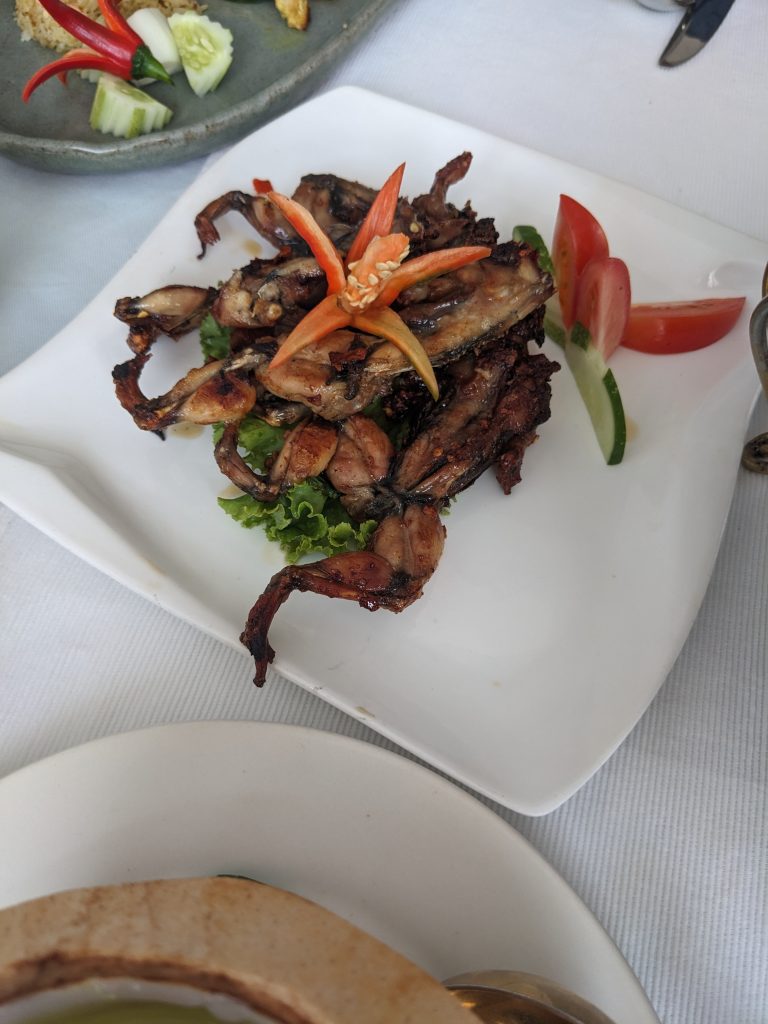
Since we are on an organized tour, many of our days include a lunch provided by the travel company. These have mostly been at restaurants geared to the Western tour groups. Our first meal in Cambodia was at at restaurant that offered many Cambodian specialties. It was on the expensive side. Because we tried so many different dishes the bill was over $100 for four people. Fried frog legs was one of the specialties. It was probably the best of the places our guide took us to over 3 days.
We stayed at the Saem Siemreap Hotel which was very nice but not really walking distance to any tourist sites. There was a tuk tuk stand outside the hotel and the sights a short $3 tuk tuk ride away. The tuk tuks are open air carts pulled by a motorcycle. Lots of fun. Drivers in Cambodia are actually quite safe – including motorcyclists and cars. The hotel is built in a tropical style from colonial times with hallways and public areas open, wood floors and traditional dark furniture. All the rooms have balconies.
We had a free evening on our arrival day. We took a tuk tuk ride to the famous Pub Street, the entertainment district for the tourists. It is a bit like the French Quarter and Bourbon Street at night. There are food stands, bars, restaurants, massage parlors and some retail shops. The visit to Night Market was a bust but we enjoyed cheap drinks and snacks at the breezy rooftop bar, Chiro Sky Lounge.
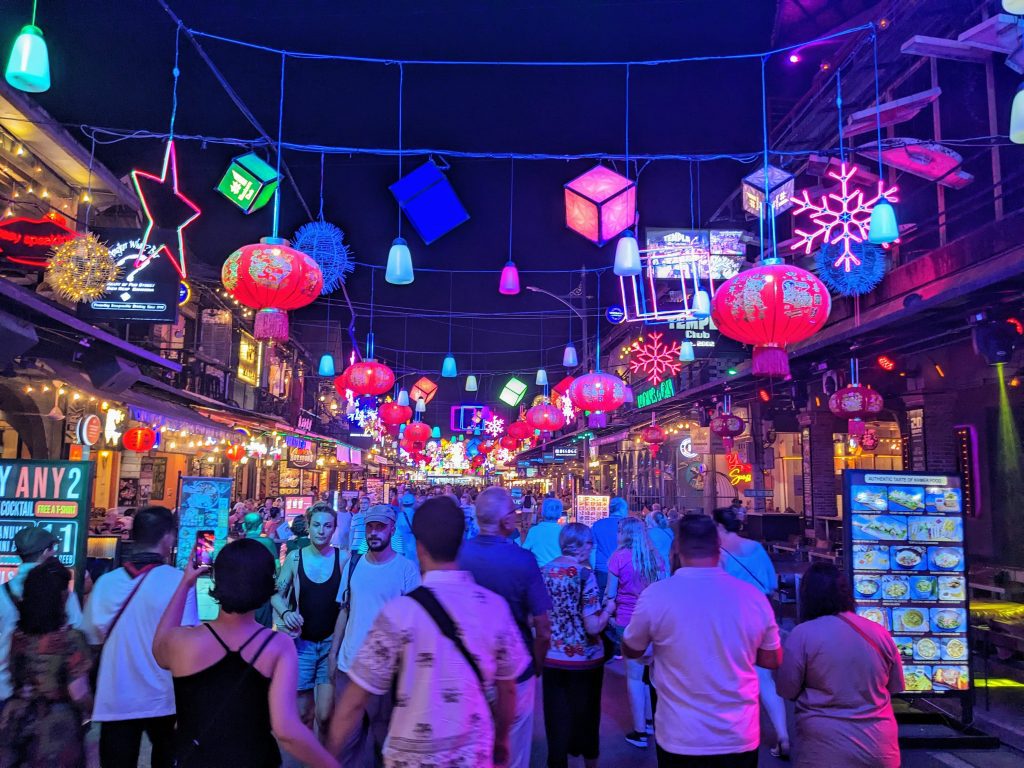
There were a few bars near the hotel. We noticed groups of young women sitting in the lobby. They are “hostesses”, for men to dine and likely sleep with. The girls don’t have a lot of opportunities here especially if they don’t finish school or have to care for their parents. Because of the shortage of women in China, the Chinese men come to Cambodia to find a woman to father a child with. If it’s a son they take the baby back to China and leave mother.
55% of families in Cambodia live in poverty. Many farmers send their children to work on the farms and in factories instead of school. Public school is free but more affluent families also send their children to private tutors, which is where they get more difficult math and science classes. I loved seeing the groups of children in their blue and white uniforms riding their bikes home for lunch.
The land in this area is very flat with much agriculture. Apparently the Chinese are buying farm land here just like in Thailand and the US.
Siem Reap is not a big city, with a population of about 40,000 mostly centered around tourism to Angkor complex. It’s is surrounded by rural jungle and agriculture. The roads are lined with small vendor stalls selling food and drink and other junk wrapped in plastic. There is so much plastic used in Asia. Bottled water, plastic bags to hold a plastic drink with a plastic straw. In the grocery store even the individual pieces of produce were shrink wrapped. Cambodia has less trash on the streets than Thailand.
Our sightseeing over two days was focused on visiting the many temples in the Angkor Complex. Angkor was the ancient capital and political and religious center of the Khmer Empire between 802 and 1432. The empire extended from the South China Sea to the Bay of Bengal covering what is now part of Vietnam, Laos, Cambodia, and Thailand.
Whoever was the self proclaimed king of the empire built magnificent temples and palaces to honor their Hindu gods and their ancestors. The Angkor complex is 77 square miles and requires motorized transportation and at least two days to see the important sights .
The treasures of these architectural wonders have long been pillaged and their wood structures have decayed. But the stone buildings have lasted 1000 years. There has been significant restoration by the Europeans and now the Chinese.
Roluos and Angkor Thom
We visited the temples of the Roluos group on our first day, the earliest settlement. These included Lolei, Bakong and Preah Ko. Many of these temples were originally dedicated to Hindu gods (Shiva) and later became places of worship for Buddists. There is much mythology and ancient stories about snakes, lions, bills and monkeys woven into the history of these sights. Our guide attempted to relate these many stories to us but a lot was lost in the telling. I think we saw the temples in somewhat order of construction so we could see how the styles and materials evolved.
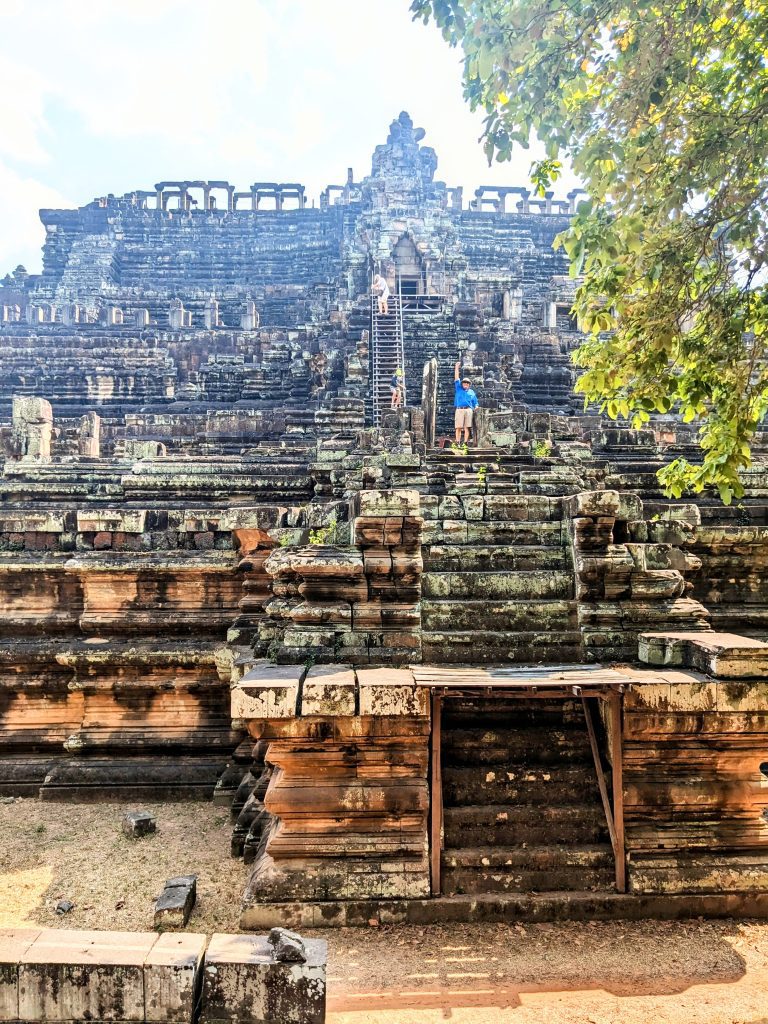
Most of the Angkor temples also became burial sites for the royalty. Cremation was the norm but kings’ ashes were buried with some of their treasures. The Bayon temple was very impressive with its carved stone faces at the entrance gates and inside the temple.
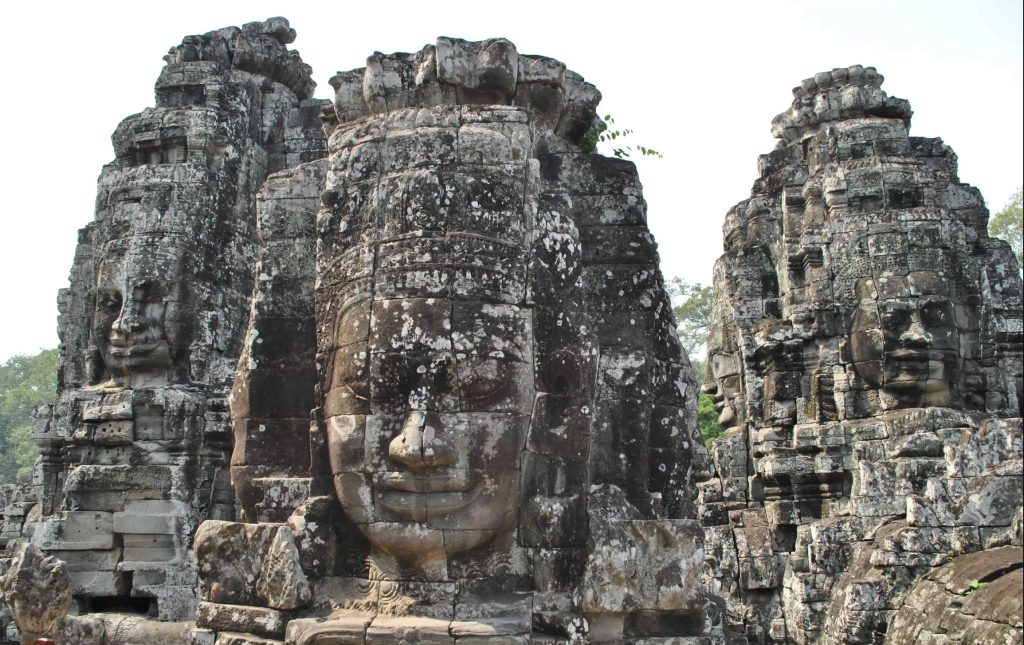
The structures in these temples were quite massive and the stones were straight and stacked without a mortar. And the carvings were intricate with histories inscribed on doorways in Sanskrit. They carved images of aspera dancers, multi armed Hindu god, huge murals depicting war and victory, everyday life, and heaven and hell. Many themes that were carried over into Christianity.
After a mediocre lunch at a filled with western tour groups, we headed to Angkor Thom. This ancient city was built in the 12th century and is protected by a huge wall and most. It has four gates (facing N, S, E and W) each with a giant stone face carving. Inside Thom we walked through Phimeanakas (palace ruins) and most impressive was the Bayon structure.
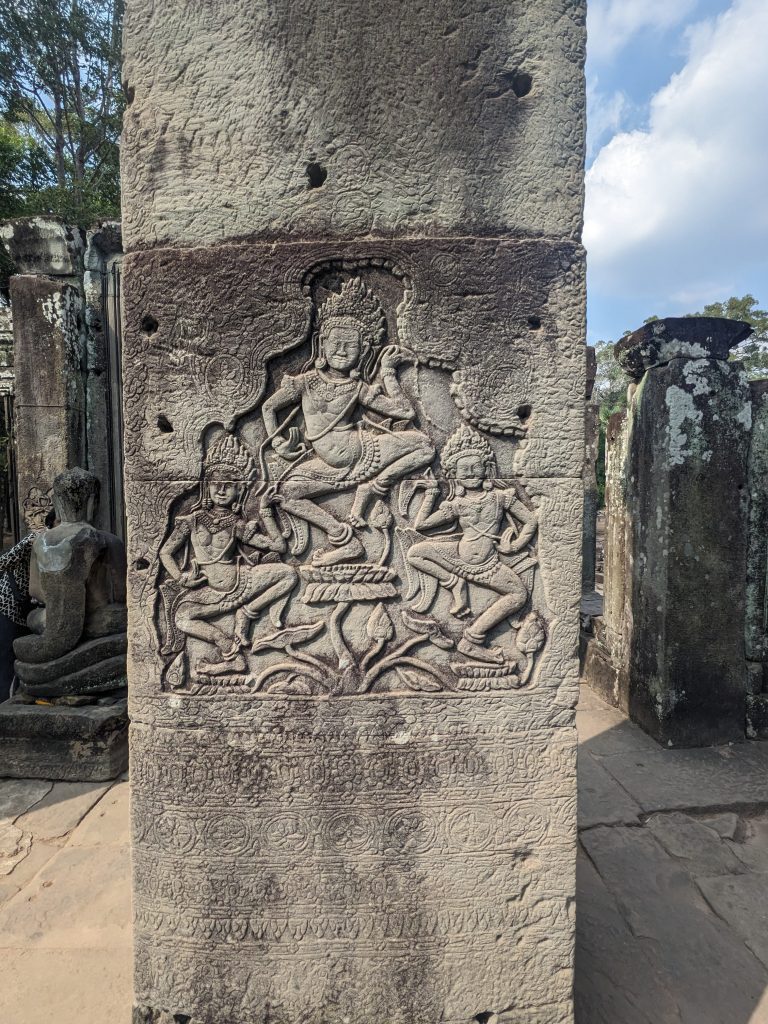
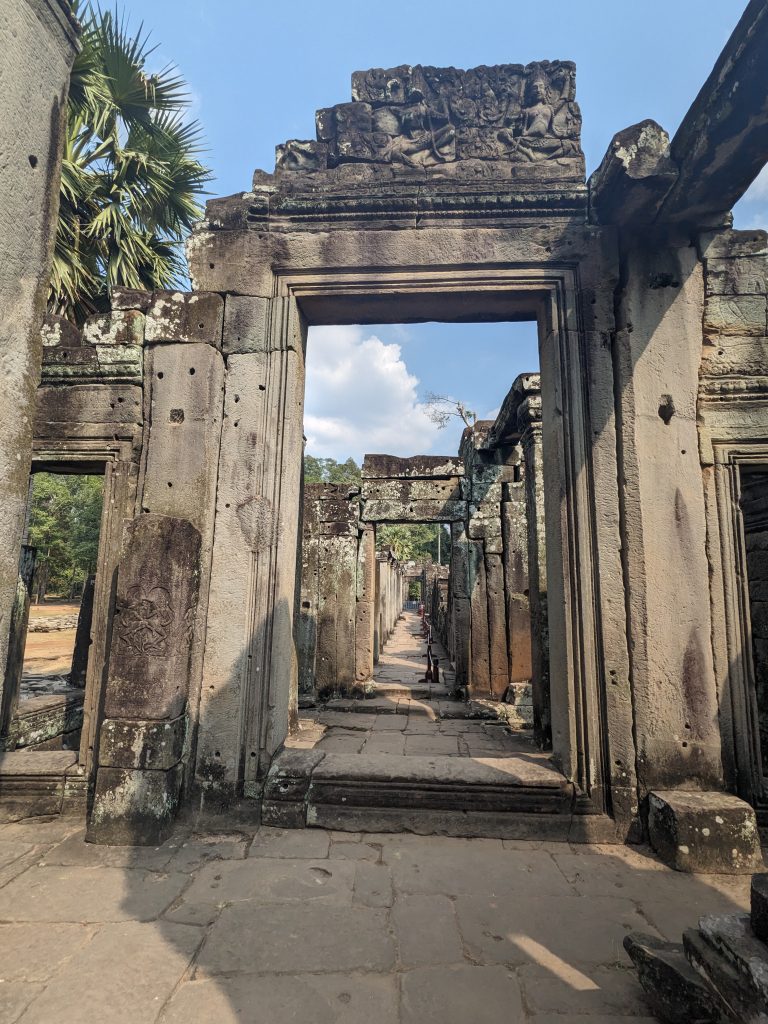
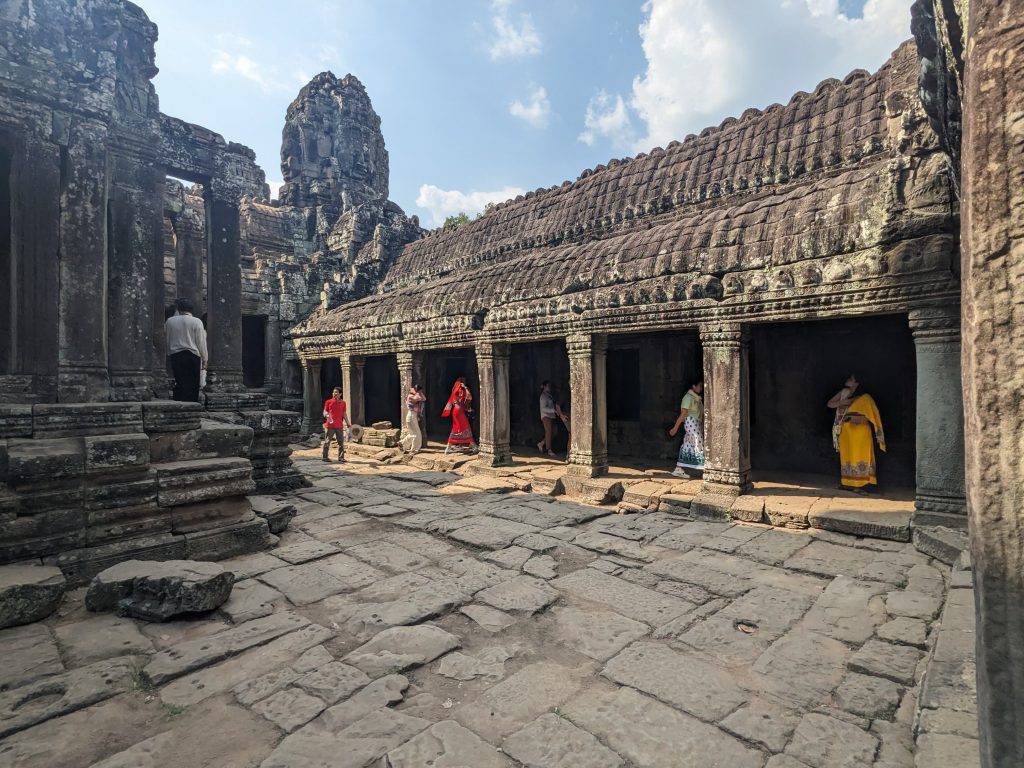
It was quite warm by the afternoon and I finally cried “uncle” and told our guide we had enough. He knows so much history and wants to share all the dates, the players and the mythology.
We changed up our planned itinerary slightly and had our guide and van driver take us for a sunset boat ride on Tonle Sap Lake to see the floating villages. It was lovely to be on the water on our private boat. We rode by the floating villages where many Vietnamese immigrants live. They are mostly fisherman and every family has a motor boat.
We had a funny experience with our dinner that night. The group voted on pizza for a change. I found a place that had more than 400 great reviews called Happy Siem Reap Pizza. It was several blocks outside the main tourist area and empty inside. The others were a little apprehensive but we went in anyways. While choosing what to order, I relooked at the reviews and realized why there were so many – the Happy refers to the extra scoops you can order that contain weed! No wonder their guests are so happy. Hah. The happy scoops cost $2 each and are not on the printed menu, maybe because pot is not legal in Cambodia. We chose to get plain ole pizza that wasn’t very good and had a good laugh at ourselves!
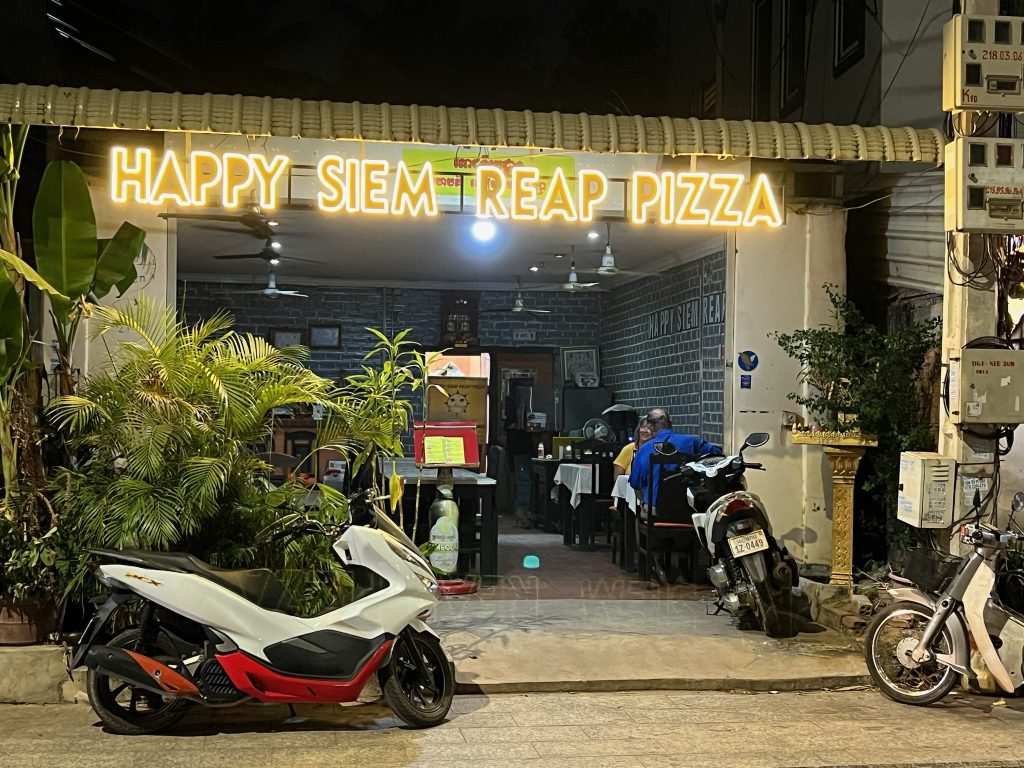
Angkor Wat and Ta Prohm
We had been scheduled to see Angkor Wat at sunset but realized it would be very hot in late afternoon. So we opted to go first thing in the morning. It was a Sunday so the sights were very crowded, at least half were local families and rest mostly Asian tour groups. I loved seeing the families posing in front of the iconic viewpoints with their Sunday best. During the day we passed many groups picnicking alongside the road, sitting on a blanket and sleeping in hammocks.
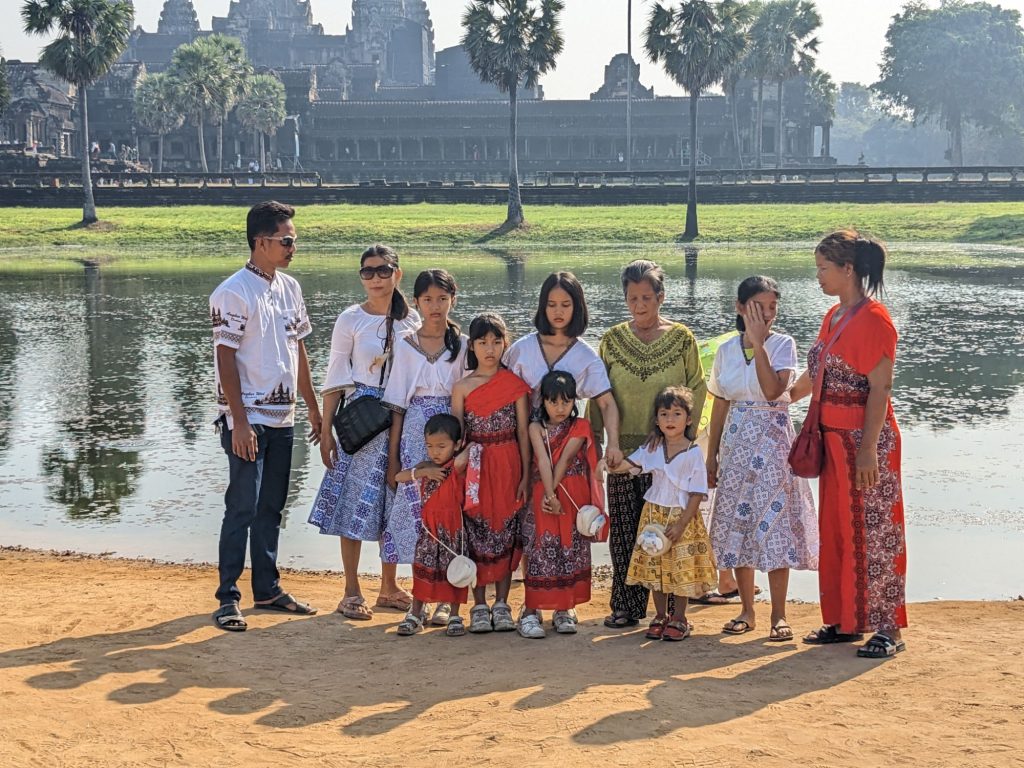
Angkor Wat is huge. Visitors cross a long causeway that would have gone over a moat. The bridges are lined with the holy snake Nagna with its body as the railings. The quintessential photo of Angkor Wat is taken at the west entrance with the structure reflected in the lake. However since we went in the morning, we were facing the sun and the photos did not capture the same scene as we would have seen at sunset. We should have considered a sunrise visit. However the skies are very hazy and the sunrises and sunsets on this trip have not been particularly photo worthy. There is a burning smell always, from the many open cooking fires and probably the burning of garbage.
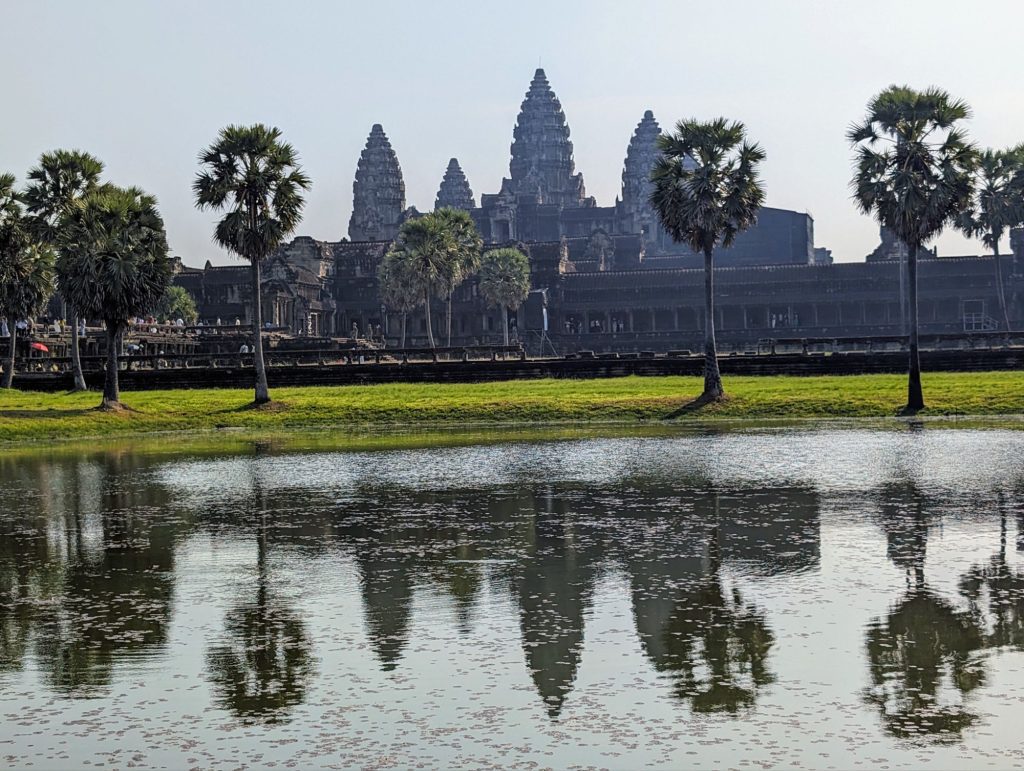
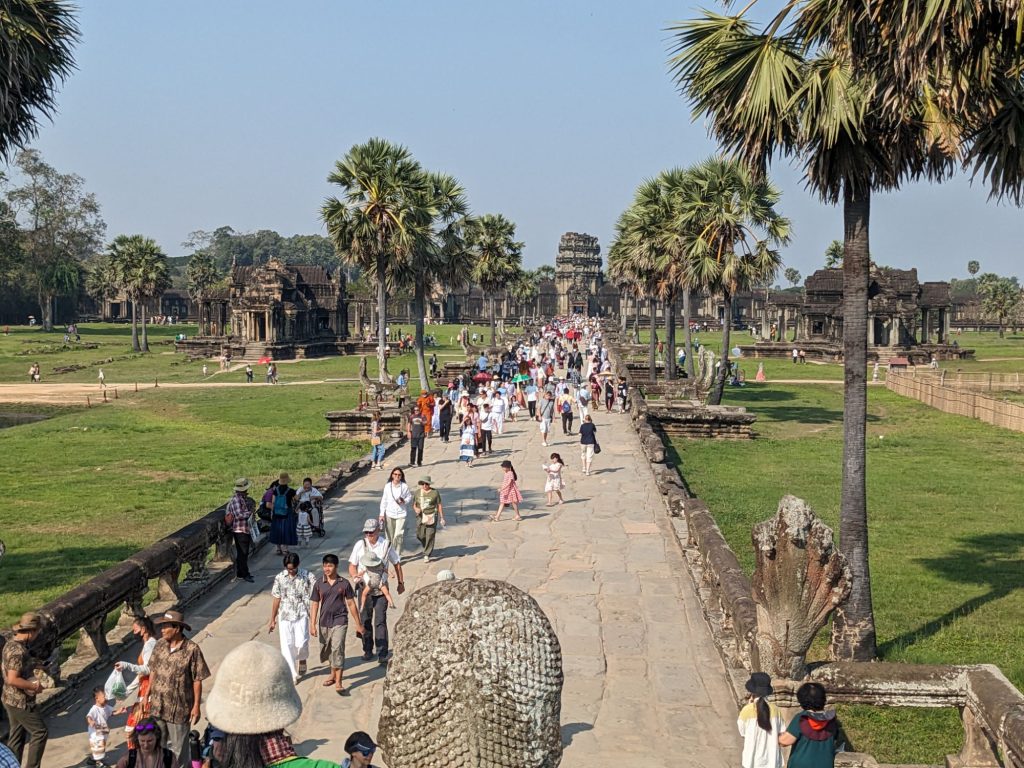
It is mind boggling that these societies 1000 years ago could envision such grand edifices and then execute over several decades. There was one group of workers who quarried and transported the stone over many miles to the building site. Then the engineers and architects directed the construction while the artists and craftsmen did the decor and intricate carvings.
The most interior structure, the Central Sanctuary, in Angkor Wat is built like a pyramid with very steep stairs on each of the four sides. Visitors could only climb up at the eastern side on a steep staircase that had been constructed over the ancient one. The old stairs used to be accessible until an 85 year old Japanese couple slipped on wet stairs and died from their injuries about 20 years ago.
Three of the group (not me) made the climb and I got a kick out of watching young and old make their way up and down. I should have gone as I saw old Asian women in sandals making their way down, even one woman on her bottom.
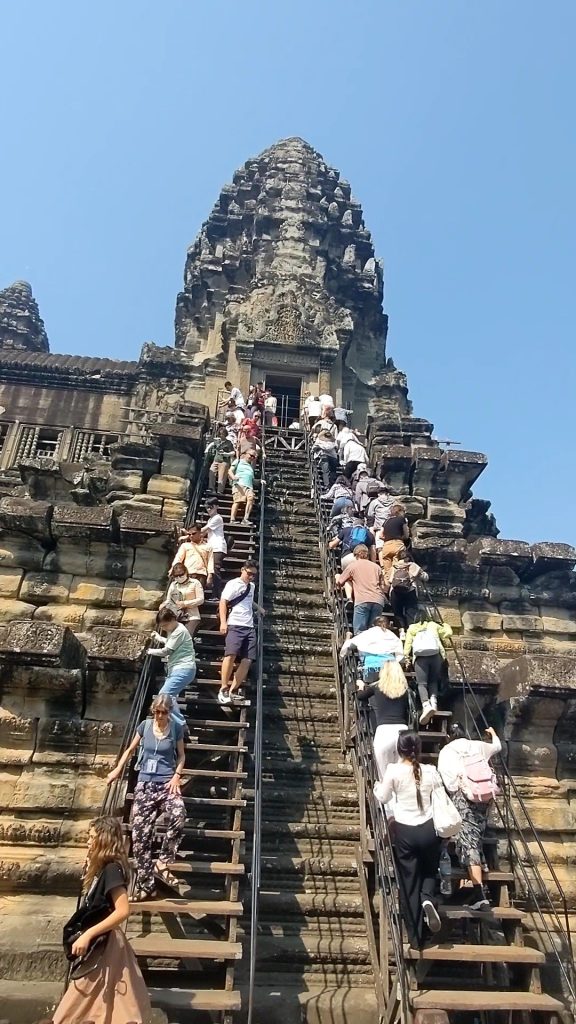
Angkor Wat is the largest religious monument in the world. It was built in the 12th century to honor the Hindu god Vishnu. The layout, design and decor are full of symbolism. The walls (called galleries) are decorated with intricate bas reliefs that tell complicated stories. The southern end of the East gallery depicted heaven, earth and hell and then the story of “The Churning of the Sea of Milk”. This myth involved the holy snake, the warriors, milk of immortality, the god Vishnu, a tortoise, a sinking mountain and a churning sea. Moen went into great detail for quite a long time. However his body language was fun as he acted out the story.
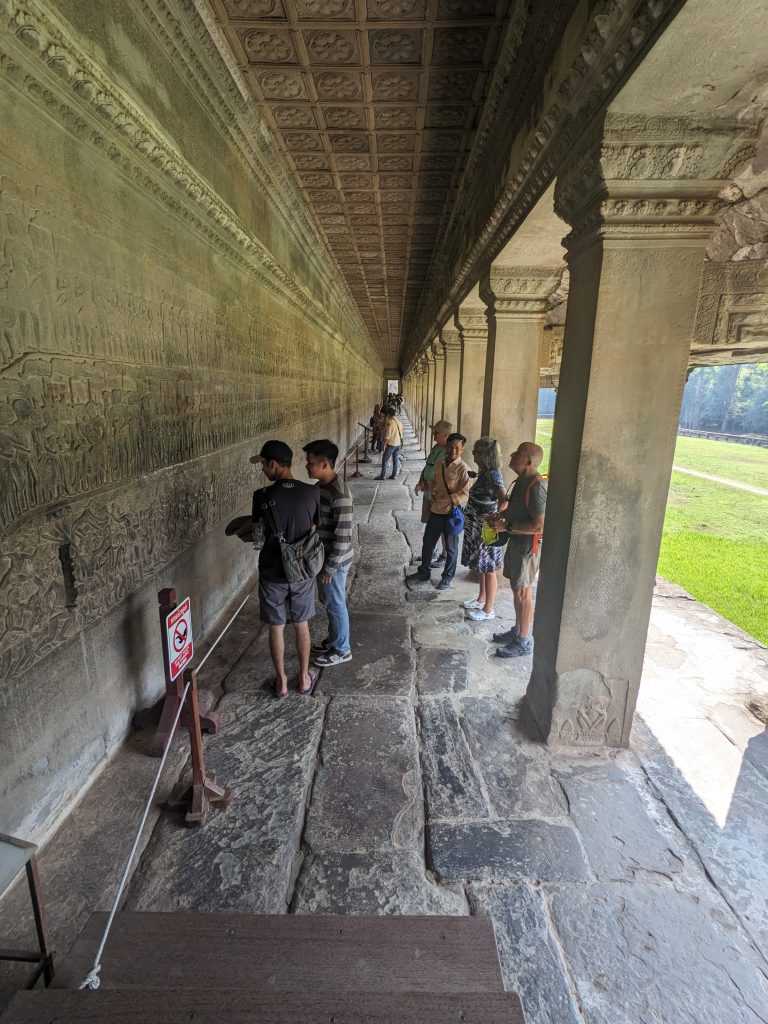
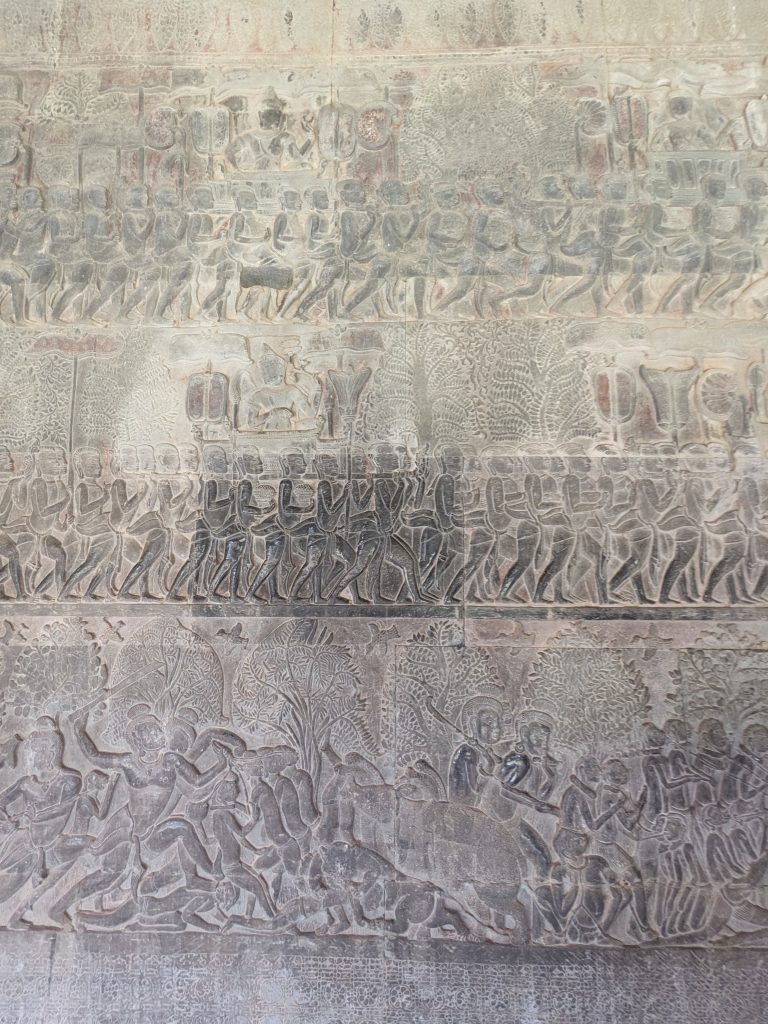
Inside the Angkor Wat temple were many corridors with door frames so straight you thought you were looking in a mirror. A few Buddha statues remained but all the decor and treasures that must have lined these walls was long gone.
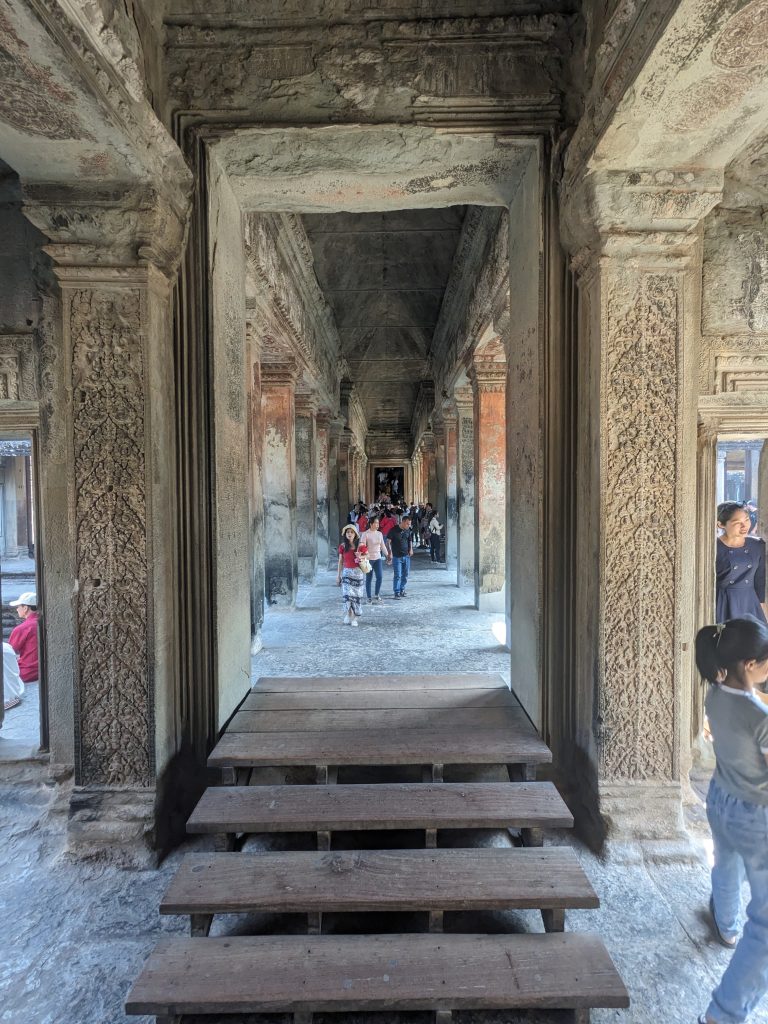
Ta Phrom
After a lunch break, we headed to Ta Prohm in our tuk tuk cabs. This former monastery site, built in 12th century, was made famous because scenes from the movie Tomb Raider were filmed here. The site is well known for the huge banyon trees whose roots are smothering the temple remains. The French did some restoration in the 19th century to rebuild structures that had collapsed but nature continues to reclaim its domain. Ta Prohm was very crowded on a Sunday afternoon and everyone wanted to take their picture in front of the tree roots. This was the one site where we could not go inside most of the temple structures.
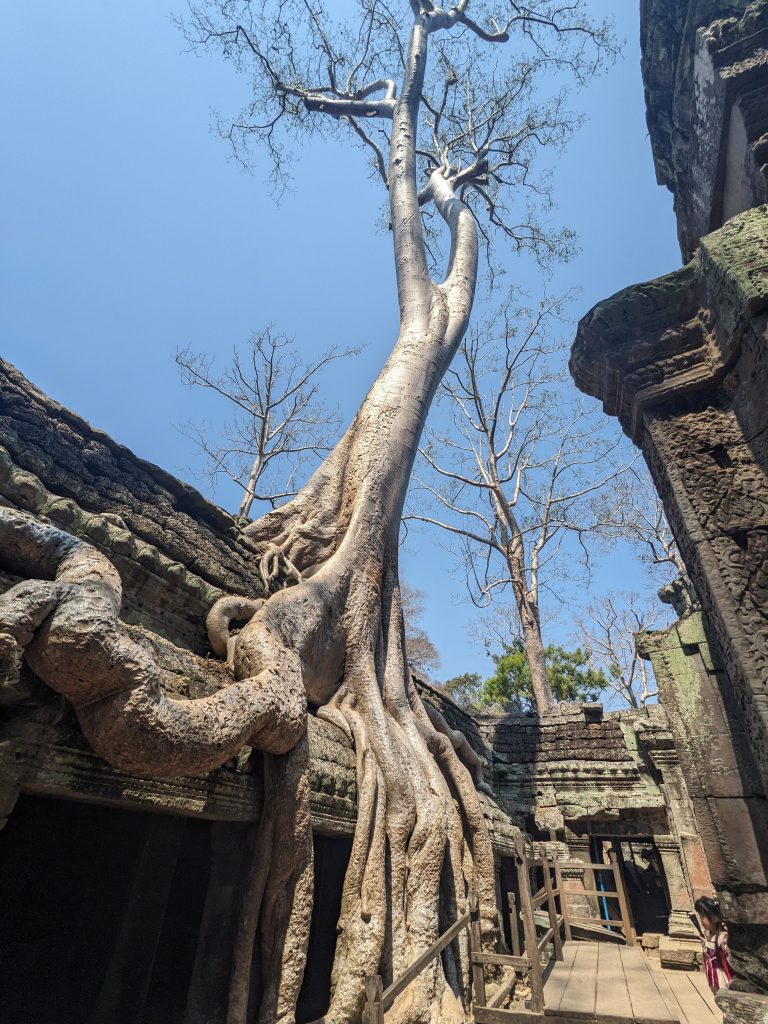

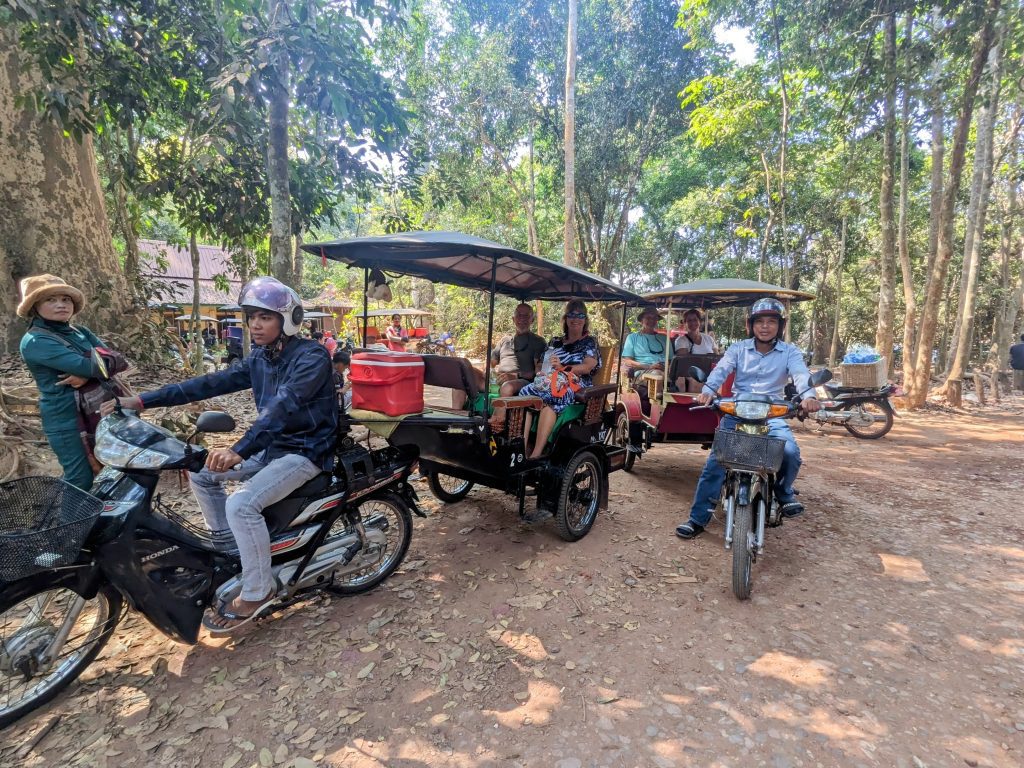
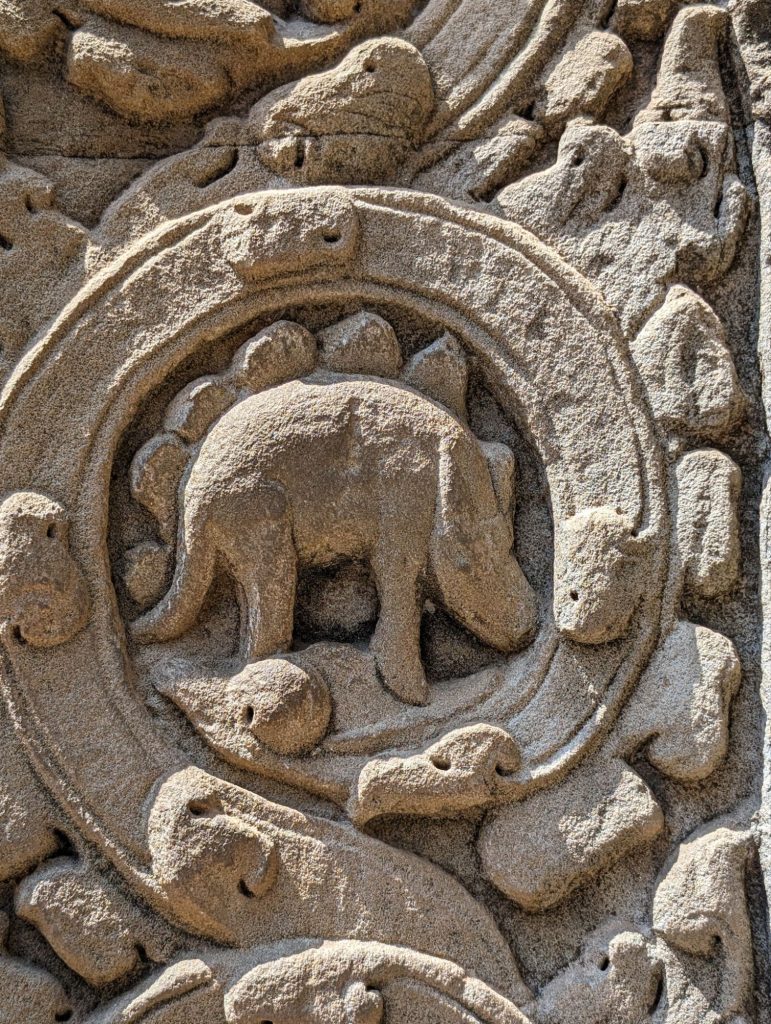
There is a small carving on a stone column that appears to be a dinosaur, possibly a stegosaurus. A mystery – how did they know what a dinosaur looked like?
After a hit day of touring, we had some time to chill at the hotel before heading to our rooftop dinner reservation at Sokkhak River Lounge. It was a beautiful venue with plants and lights and purple decor. The food was the best we had in Cambodia to date. We tried fried calamari and shrimp, spring rolls and fish cake for starters. The fish cake was okay but others were excellent. For mains we had duck, provincial chicken curry with sweet potatoes, cambodian shrimp pancake, best sauteed eggplant ever, sauteed mushroom stems, and roast chicken. Mai Tais were expensive by Cambodian standards but still cheap for us ($5.80). This rooftop dining experience was a great ending to our short stay in Siem Reap.
